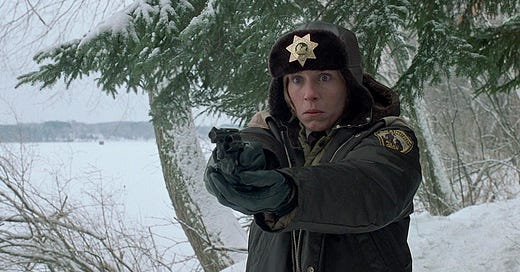Weekly Watches: April 3, 2024
Sharing Our Recent Discoveries: Weekly Watches with 100 Movies Every Catholic Should See
Fargo (1996)
By
I have a severe dislike of North Dakota. Its flatness means you can truly see the ends of the earth as you drive across the state, and those ends are not pretty. That dislike kept me from the Coen Brothers’ Fargo for years. While I like many of their films, especially No Country for Old Men and True Grit, Fargo felt as exciting to me as taking a return trip to the state the film is based in.
And yet…the film is a great one. It’s not for everyone, mind you. Its uncompromising bleakness and unflinching — to the point of comedy — look at the darkness in men’s souls can be off-putting for some. But, in the character of Marge (played wonderfully by Frances McDormand), the Coen Brothers present a light in the darkness. Even as William H. Macy’s character is trying to destroy his family, Frances McDormand’s is trying to build one, showing that, even in the midst of kidnappings, gunfights, ransoms, and woodchippers, there is still good in this world.
Oh, and by the way? Its shot by Roger Deakins. North Dakota may not be pretty, but Deakins’ pictures always are. Don’t make the same mistake I did and keep yourself from this mid-90s masterwork.
The Big Country (1958)
By
I don't know that I've seen any Western fulfill the genre's potential for pure visual beauty as well as The Big Country. Director William Wyler and cinematographer Franz Planer put thought and purpose into every single shot, composing each like a rich painting to bring out the beauty of the Old West: sometimes warm and inviting, sometimes stark and terrible. They make the country feel big, indeed, making many of the petty character squabbles feel insignificant against the vast majesty of the landscape.
And the squabbles are petty indeed. Our protagonist, James McKay (played masterfully by Gregory Peck), is a retired sea captain come to the West to be with his fiancée, Pat Terrill. Although most people treat the country as something hostile to be tamed, McKay drinks in its beauty, used to the vast open spaces very much like the sea. However, he soon finds himself in the middle of a feud between the Terrills, led by Pat's father (Confederate) Major Henry Terrill (Charles Bickford), and the Hannesseys, led by patriarch Rufus (a delightfully menacing Burl Ives). These two ranching families are fighting over access to a patch of water on land owned by neither of them, each determined to cut the other off before the other finds a way to end their access. McKay, disgusted by this feud and the constant need to demonstrate power and manliness in this culture of bravado, buys the disputed land in hopes of keeping the peace, but the bad blood runs deep between these families and their feud has become as big as the country.
McKay works as the arbiter between the two sides, the virtuous mean towards which man should strive. He refuses to rise to the bait of the more seasoned cowhands who attempt to test his masculinity. However, this is not because he is weak or incapable, as they seem to think. He just knows that he has nothing to prove; he is perfectly secure in himself, whereas the other men around him seem to constantly need to prove their masculinity. After he gets into a bout of fisticuffs with Steve Leech (an appropriately gruff Charlton Heston), he asks the question "and what did we prove here, Steve?" By the end of the film it is obvious that the Terrills and the Hannasseys would fight over literally anything just to fight; the water (which they both have been granted unlimited access to) is merely the pretext for this series of one-upmanship. McKay, by question why and not seeking to prove his dominance over all around him, represents a better way forward for the West and for a man progressing in virtue, thus lending a fantastic morally upright character to the compelling story and stunning visual beauty of The Big Country.
Baby Driver (2017)
By
I’m a big fan of Edgar Wright’s catalog of movies for a lot of reasons, including the quick and witty writing, often brilliant chemistry between the cast and the numerous nods he includes to famous movie scenes throughout the history of cinema. However, I recently re-watched Baby Driver (his pet project of 20 some years) and was so impressed, I would be shocked if anyone didn’t consider this to be his magnum opus. The plot centers around Baby, a getaway driver in the criminal underground who is working to pay off a debt to Doc, whom he crossed at a young age. Luckily and unluckily for Baby, he is very good at what he does and is able to care for his deaf foster-father Joe, while yearning for the day when he can leave his life of crime behind. Things intensify as he falls in love with a waitress named Debora, and Baby must complete one last job and grapple with his role as a getaway driver to get out of the criminal underworld with his and his loved ones’ lives. A fast-paced, action-packed adventure filled with a rock-filled soundtrack that makes the Guardians of the Galaxy song list seem mundane, Baby Driver is fueled at its core by amazing performances by the cast and brilliant camera work by the crew.
The cast includes many big names such as Ansel Elgort (of The Fault in our Stars and more recently, West Side Story) as Baby, Kevin Spacey as Doc, and Lily James as Debora, but also includes a great supporting cast including Jamie Foxx, Job Hamm, and Eiza Gonzalez. Elgort does an incredible job of making the watcher feel the emotional struggle that Baby goes through, but Spacey steals the show as the tough but caring underworld mentor of the protagonist (although I am also partial to Hamm’s performance as a member of the criminal crew Baby works with). And as far as the cinematography goes, one only needs to look at the opening scene to know that this movie is a feast for action junkies. Shootouts, foot races, and of course plenty of car chase scenes left me gripping my seat with a massive grin on my face. I won’t speak about the end of the movie to avoid spoilers, but it also has a solidly redemptive message and a fairly consistent theme throughout the story about redemption and doing the right thing. Overall, Baby Driver is a well shot action movie that thrills the viewer while still taking the time to tell a redemptive, compelling story.
Dark City (1998)
By
Everyone has heard of The Matrix. But few may realize that in the year prior, one of the most original and spectacularly designed sci-fi films in the 90s was put to screen. Dark City remains a bit of a niche for lovers of the genre (such as myself) but with the recent release of a director’s cut and some critical backing, it is beginning to be appreciated by wider audiences. Sci-fi offers filmmakers an opportunity to build some truly fantastic worlds and is one of my favorite aspects of this remarkable genre. Dark City’s production design is downright incredible, blending elements from German Expressionism seen in Fritz Lang’s iconic Metropolis with the seedy criminal underworld of Film Noir and subtle nods to The Terminator and Blade Runner. A closer look even reveals references to the paintings of Edward Hopper, most notably Nighthawks.
Great sci-fi films often wrestle with the universal question of what makes us human. Amidst a bleak and unnerving world, full of crime and human depravity, Dark City follows one man’s journey to uncover and ultimately free his world from an unseen malevolent force which seeks to subjugate humanity to a never-ending cycle of hallucinatory manipulation and enslavement. He must come to terms with his own past and learn to forgive those closest to him while contending with truths which quite literally shake the foundation of the world he knows. Amidst an exquisitely designed world, Dark City offers a truly thought provoking experience, setting it on par with many of greats in the sci-fi cinematic canon. I can’t say everyone will enjoy it as it portrays some of the darker elements of human nature, but to those who are willing to embark on this journey, it is one that you will not forget anytime soon.












